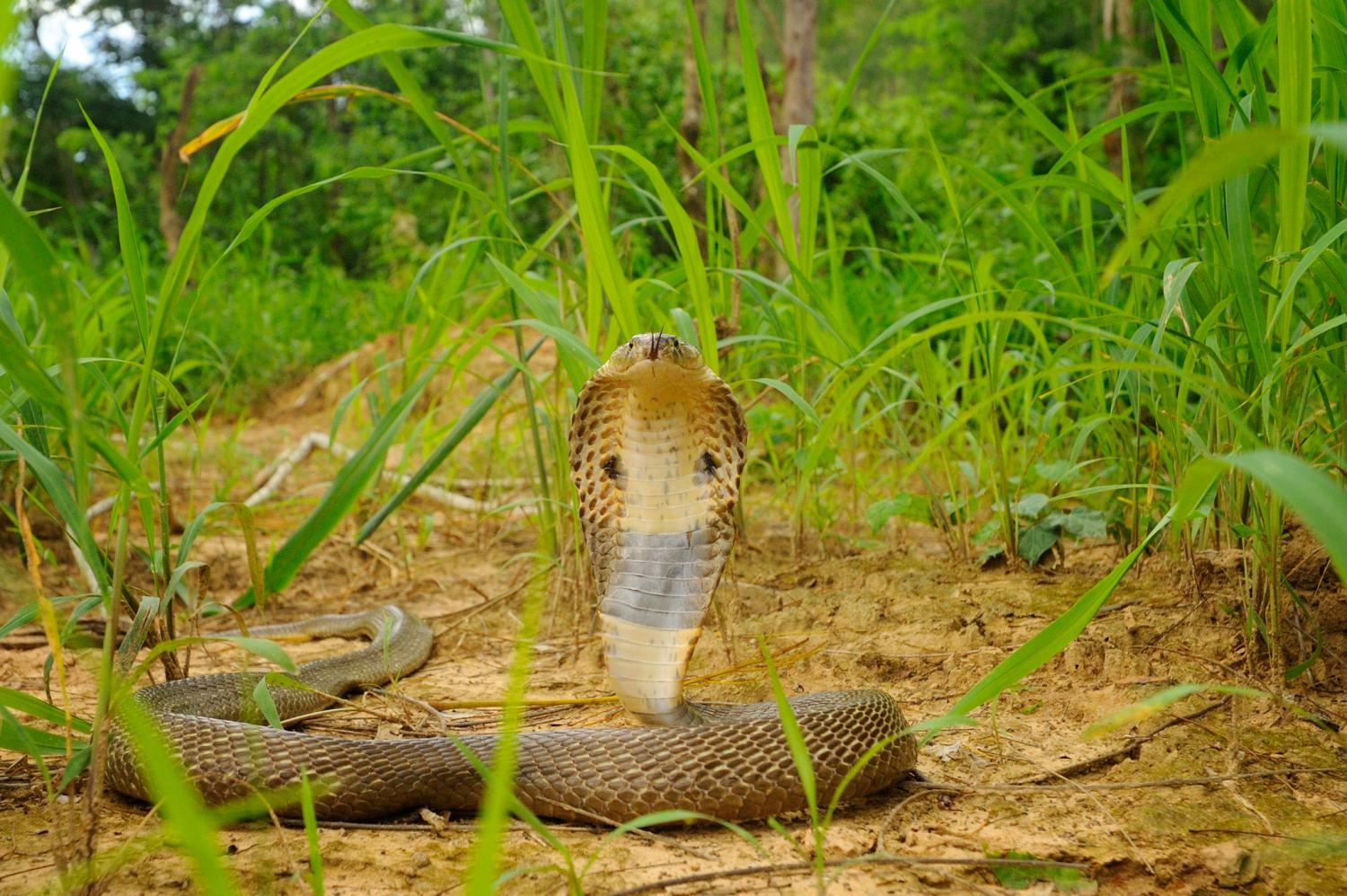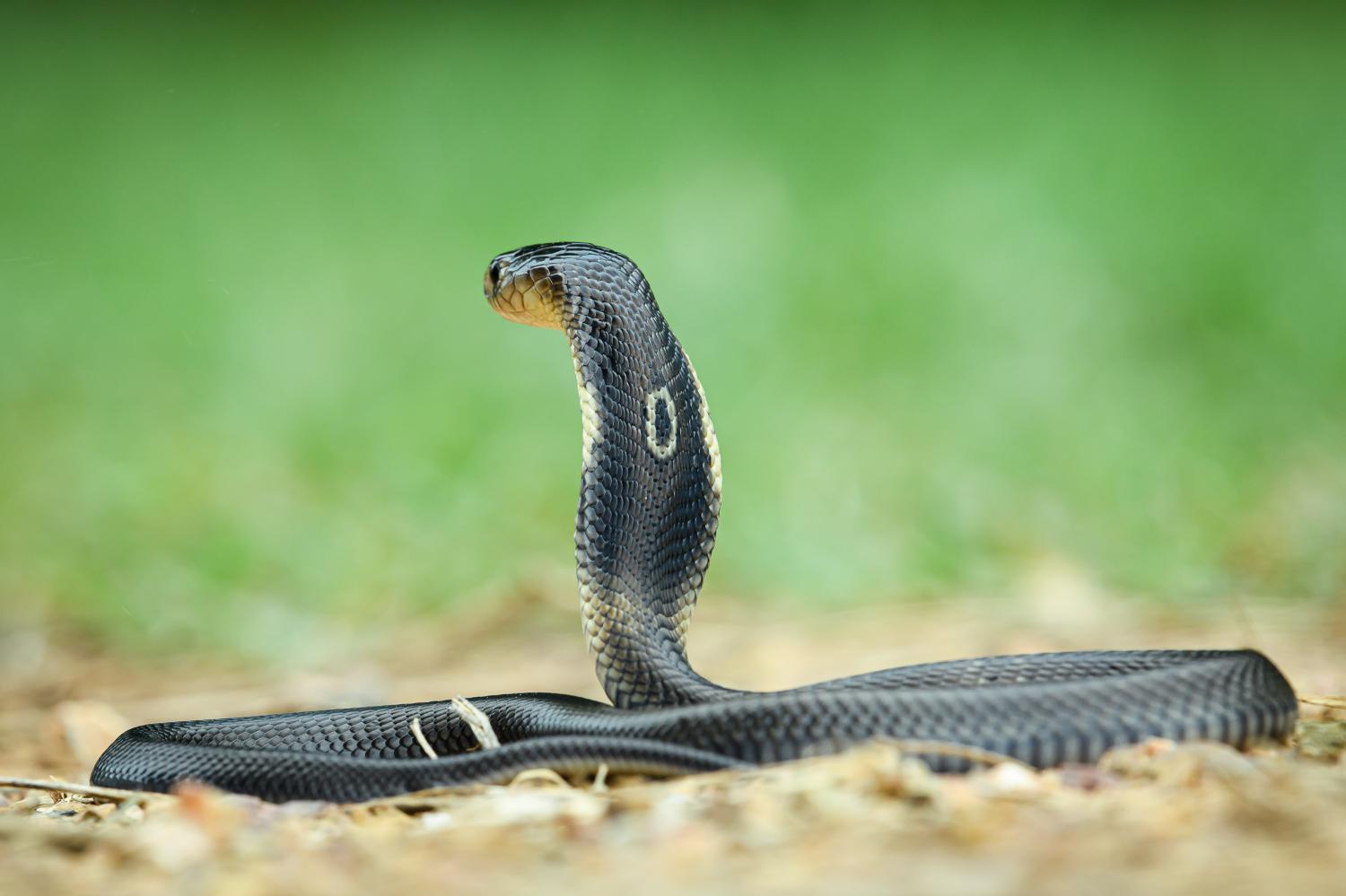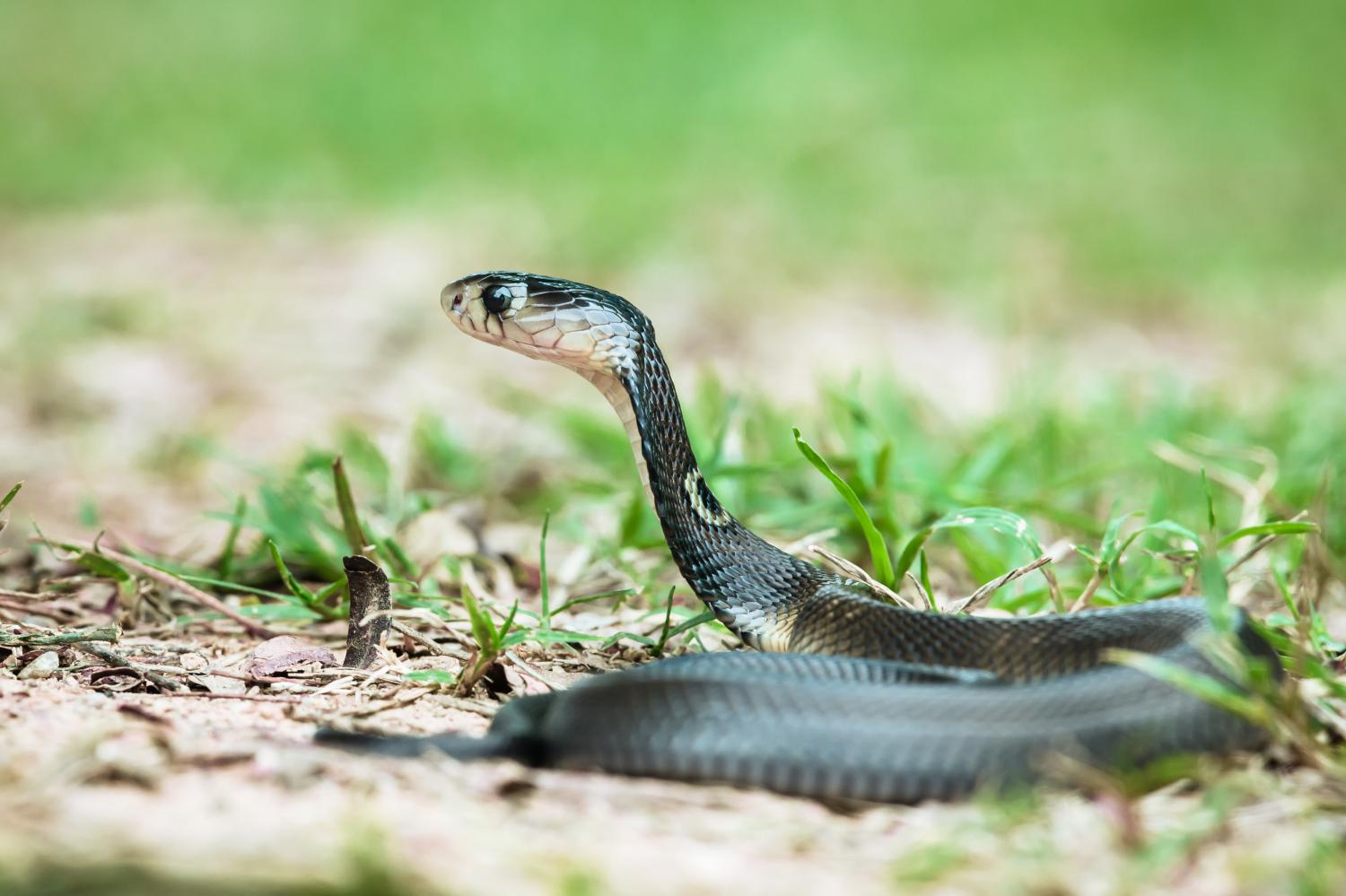Species of Thailand
Monocled cobra
Naja kaouthia
René Primevère Lesson, 1831
In Thai: งูเห่าไทย, ngu haow Thai
The monocled cobra (Naja kaouthia), also called monocellate cobra, is a cobra species widespread across South and Southeast Asia and listed as Least Concern by IUCN.
Taxonomic history
In 1831, René Lesson first described the monocled cobra as a beautiful snake that is distinct from the spectacled cobra, with 188 ventral scales and 53 pairs of caudal scales.
Since then, several monocled cobras were described under different scientific names:
- In 1834, John Edward Gray published Thomas Hardwicke’s first illustration of a monocled cobra under the trinomial Naja tripudians var. fasciata.
- In 1839, Thomas Cantor described a brownish monocled cobra with numerous faint yellow transverse stripes and a hood marked with a white ring under the binomial Naja larvata, found in Bombay, Calcutta, and Assam.
Several varieties of monocled cobras were described under the binomial Naja tripudians between 1895 and 1913.
- N. j. var. scopinucha 1895
- N. j. var. unicolor 1876
- N. j. var. viridis 1913
- N. j. var. sagittifera 1913
In 1940, Malcolm Arthur Smith classified the monocled cobra as a subspecies of the spectacled cobra under the trinomial Naja naja kaouthia.
Characteristics
The monocled cobra has an O-shaped, or monocellate hood pattern, unlike that of the Indian cobra, which has the "spectacle" pattern (two circular ocelli connected by a curved line) on the rear of its hood. Coloration in the young is more constant. The dorsal surface may be yellow, brown, gray, or blackish, with or without ragged or clearly defined cross bands. It can be olivaceous or brownish to black above with or without a yellow or orange-colored, O-shaped mark on the hood. It has a black spot on the lower surface of the hood on either side, and one or two black cross-bars on the belly behind it. The rest of the belly is usually the same color as the back, but paler. As age advances, the snake becomes paler, wherein the adult is brownish or olivaceous. The elongated nuchal ribs enable a cobra to expand the anterior of the neck into a “hood”. A pair of fixed anterior fangs is present. The largest fang recorded measured 6.78 mm cm. Fangs are moderately adapted for spitting. Adult monocled cobras reach a length of 1.35 to 1.5 m with a tail length of 23 cm. Many larger specimens have been recorded, but they are rare. Adults can reach a maximum of 2.3 m in length.
Scalation
They have 25 to 31 scales on the neck, 19 to 21 on the body, and 17 or 15 on the front of the vent. They have 164 to 197 ventral scales and 43 to 58 subcaudal scales.
Monocled cobras tend to have more than one cuneate scale on each side. The shape of the frontal scale is short and square. Ventrals in males range from 170 to 192, in females from 178 to 197. Subcaudals in males range from 48 to 61, in females from 46 to 59.
Distribution and habitat
Monocled cobras are distributed from India in the west through to China, Vietnam and Cambodia. They are also found on the Malay Peninsula and are native to Bangladesh, Bhutan, Myanmar, Laos, Nepal, and Thailand.
These cobras can adapt to a range of habitats, from natural to anthropogenically impacted environments. They prefer habitats associated with water, such as paddy fields, swamps, and mangroves, but can also be found in grasslands, shrublands, and forests. The species also occurs in agricultural land and human settlements including cities. They can be found at elevations of up to 1000 m above sea level.
Ecology and behaviour
Monocled cobras are terrestrial and most active at dusk. In rice-growing areas, they hide in rodent burrows in the dykes between fields and have become semi-aquatic in this type of habitat. Juveniles feed mostly on amphibians whereas adults prey on small mammals, snakes and fish. When disturbed they prefer to take flight. However, when threatened they will raise the anterior portions of their bodies, spread their hood, usually hiss loudly, and strike in an attempt to bite and defend themselves.
They are often found in tree holes and areas where rodents are plentiful.
Some populations of the monocled cobra have the ability to spit venom.
Reproduction
This is an oviparous species. Females lay 16 to 33 eggs per clutch. Incubation periods range from 55 to 73 days. Egg-laying takes place January through March. The females usually stay with the eggs. Some collaboration between males and females has been reported in Naja naja x Naja kaouthia - hybrids.
Conservation status
This species has been assessed as Least Concern by IUCN owing to its large distribution, tolerance of a broad range of habitats including anthropogenically altered environments, and its reported abundance. No major threats have been reported, and the species is not thought to be undergoing a significant population decline. In areas where the distribution of this species coincides with protected areas, probably providing small safeguards. Monocled cobras are harvested for the skin trade, however, collection from the wild is minimal and not likely to cause significant population declines. Naja kaouthia is listed on CITES Appendix II.
Venom
The Naja kaouthia venom sources from three different localities were reported to exhibit different intravenous and subcutaneous median lethal dose: Thailand, 0.18-0.22 µg/g; Malaysia, 0.90-1.11 µg/g; and Vietnam, 0.90-1.00 µg/g, of mouse body weight. The proteomics finding revealed that the neurotoxin profiles of these Naja kaouthia were substantially different, reflecting the distinct difference in their lethal potency and response to antivenom neutralization.
The major toxic components in cobra venoms are postsynaptic neurotoxins, which block the nerve transmission by binding specifically to the nicotinic acetylcholine receptor, leading to flaccid paralysis and even death by respiratory failure. The major α-neurotoxin in Naja kaouthia venom is a long neurotoxin, α-cobratoxin; the minor α-neurotoxin is different from cobrotoxin in one residue. The neurotoxins of this particular species are weak. The venom of this species also contains myotoxins and cardiotoxins.
In case of intravenous injection the tested in mice is 0.373 mg/kg, and 0.225 mg/kg in case of intraperitoneal injection. The average venom yield per bite is approximately 263 mg (dry weight).
The monocled cobra causes the highest fatality due to snake venom poisoning in Thailand. Envenomation usually presents predominantly with extensive local necrosis and systemic manifestations to a lesser degree. Drowsiness, neurological and neuromuscular symptoms will usually manifest earliest; hypotension, flushing of the face, warm skin, and pain around bite site typically manifest within one to four hours following the bite; paralysis, ventilatory failure or death could ensue rapidly, possibly as early as 60 minutes in very severe cases of envenomation. However, the presence of fang marks does not always imply that envenomation actually occurred.
In a preliminary study, extract of Mimosa pudica plant has been shown to possibly have neutralizing effects on the toxins present in this venom.
This article uses material from Wikipedia released under the Creative Commons Attribution-Share-Alike Licence 3.0. Eventual photos shown in this page may or may not be from Wikipedia, please see the license details for photos in photo by-lines.
Scientific classification
- Kingdom
- Animalia
- Phylum
- Chordata
- Class
- Reptilia
- Order
- Squamata
- Suborder
- Serpentes
- Family
- Elapidae
- Genus
- Naja
- Species
- Naja kaouthia
Common names
- German: Monokelkobra
- English: Monocled cobra
- French: Monocellate cibra
- Thai:
- งูเห่าไทย, ngu haow Thai
- งูเห่านา, ngu haow naa
- งูเห่าหม้อ, ngu haow moor
- งูเห่าดอกจัน, ngu haow dok jann
- งูเห่าสีนวล, ngu hao see nuan
- งูเห่าสุพรรณ, ngu hao Suphan
Conservation status

Least Concern (IUCN3.1)
Photos
Please help us review our species pages if wrong photos are used or any other details in the page is wrong. We can be reached via our contact us page.
Range Map

- Amphawa District, Samut Songkhram
- Ao Luek District, Krabi
- Aranyaprathet District, Sa Kaeo
- Ban Dung District, Udon Thani
- Ban Laem District, Phetchaburi
- Ban Lat District, Phetchaburi
- Ban Na San District, Surat Thani
- Ban Pong District, Ratchaburi
- Ban Ta Khun District, Surat Thani
- Bang Bua Thong District, Nonthaburi
- Bang Kapi District, Bangkok
- Bang Khae District, Bangkok
- Bang Khun Thian District, Bangkok
- Bang Kruai District, Nonthaburi
- Bang Na District, Bangkok
- Bang Nam Priao District, Chachoengsao
- Bang Pa In District, Phra Nakhon Si Ayutthaya
- Bang Pahan District, Phra Nakhon Si Ayutthaya
- Bang Phae District, Ratchaburi
- Bang Phli District, Samut Prakan
- Bang Sao Thong District, Samut Prakan
- Bang Saphan District, Prachuap Khiri Khan
- Bang Yai District, Nonthaburi
- Cha-uat District, Nakhon Si Thammarat
- Chae Son National Park
- Chana District, Songkhla
- Chiang Dao District, Chiang Mai
- Chulabhorn District, Nakhon Si Thammarat
- Damnoen Saduak District, Ratchaburi
- Dan Sai District, Loei
- Doi Ang Khang
- Doi Inthanon National Park
- Doi Phu Kha National Park
- Don Mueang District, Bangkok
- Hat Yai District, Songkhla
- Hua Hin District, Prachuap Khiri Khan
- Hua Sai District, Nakhon Si Thammarat
- Huai Kha Khaeng Wildlife Sanctuary
- In Buri District, Sing Buri
- Kaeng Krachan District, Phetchaburi
- Kaeng Krachan National Park
- Kanchanadit District, Surat Thani
- Kathu District, Phuket
- Khanom District, Nakhon Si Thammarat
- Khao Nam Khang National Park
- Khao Phanom District, Krabi
- Khao Phra - Bang Khram Wildlife Sanctuary
- Khao Sok National Park
- Khao Yai National Park
- Khian Sa District, Surat Thani
- Khlong Luang District, Pathum Thani
- Khlong Sam Wa District, Bangkok
- Khlong Thom District, Krabi
- Khuan Don District, Satun
- Khura Buri District, Phang Nga
- Ko Chang District, Trat
- Ko Lanta District, Krabi
- Ko Pha Ngan
- Ko Samui District, Surat Thani
- Kra Buri District, Ranong
- Krasae Sin District, Songkhla
- Krathum Baen District, Samut Sakhon
- Kui Buri District, Prachuap Khiri Khan
- Kui Buri National Park
- Kumphawapi District, Udon Thani
- La-un District, Ranong
- Lak Si District, Bangkok
- Lam Luk Ka District, Pathum Thani
- Lamae District, Chumphon
- Lat Krabang District, Bangkok
- Lat Lum Kaeo District, Pathum Thani
- Lat Phrao District, Bangkok
- Mae Ramat District, Tak
- Mae Rim District, Chiang Mai
- Mae Sai District, Chiang Rai
- Mae Wong National Park
- Min Buri District, Bangkok
- Mueang Bueng Kan District, Bueng Kan
- Mueang Chachoengsao District, Chachoengsao
- Mueang Chiang Mai District, Chiang Mai
- Mueang Chumphon District, Chumphon
- Mueang Kanchanaburi District, Kanchanaburi
- Mueang Krabi District, Krabi
- Mueang Lampang District, Lampang
- Mueang Lopburi District, Lopburi
- Mueang Nakhon Sawan District, Nakhon Sawan
- Mueang Nakhon Si Thammarat District, Nakhon Si Thammarat
- Mueang Nonthaburi District, Nonthaburi
- Mueang Pathum Thani District, Pathum Thani
- Mueang Pattani District, Pattani
- Mueang Phang Nga District, Phang Nga
- Mueang Phatthalung District, Phatthalung
- Mueang Phetchaburi District, Phetchaburi
- Mueang Phichit District, Phichit
- Mueang Phitsanulok District, Phitsanulok
- Mueang Phuket District, Phuket
- Mueang Prachinburi District, Prachinburi
- Mueang Ranong District, Ranong
- Mueang Samut Prakan District, Samut Prakan
- Mueang Samut Sakhon District, Samut Sakhon
- Mueang Satun District, Satun
- Mueang Songkhla District, Songkhla
- Mueang Suphanburi District, Suphan Buri
- Mueang Surat Thani District, Surat Thani
- Mueang Trang District, Trang
- Mueang Yala District, Yala
- Na Bon District, Nakhon Si Thammarat
- Na Mom District, Songkhla
- Na Thawi District, Songkhla
- Na Yong District, Trang
- Noen Maprang District, Phitsanulok
- Nong Chok District, Bangkok
- Nong Don District, Saraburi
- Nong Khaem District, Bangkok
- Nuea Khlong District, Krabi
- Pak Kret District, Nonthaburi
- Pak Phanang District, Nakhon Si Thammarat
- Pak Phayun District, Phatthalung
- Pathio District, Chumphon
- Phan Thong District, Chonburi
- Phanom District, Surat Thani
- Phato District, Chumphon
- Photharam District, Ratchaburi
- Phra Nakhon Si Ayutthaya District, Phra Nakhon Si Ayutthaya
- Phu Ruea District, Loei
- Phuket Province
- Phunphin District, Surat Thani
- Prawet District, Bangkok
- Pua District, Nan
- Ranot District, Songkhla
- Ron Phibun District, Nakhon Si Thammarat
- Rueso District, Narathiwat
- Saba Yoi District, Songkhla
- Sai Noi District, Nonthaburi
- Sai Yok District, Kanchanaburi
- Sakaerat Environmental Research Station
- Sathing Phra District, Songkhla
- Sawi District, Chumphon
- Sena District, Phra Nakhon Si Ayutthaya
- Si Chomphu District, Khon Kaen
- Si Songkhram District, Nakhon Phanom
- Sichon District, Nakhon Si Thammarat
- Sikao District, Trang
- Singhanakhon District, Songkhla
- Suan Luang District, Bangkok
- Suan Phueng District, Ratchaburi
- Takua Pa District, Phang Nga
- Taling Chan District, Bangkok
- Tha Bo District, Nong Khai
- Tha Chang District, Surat Thani
- Tha Sae District, Chumphon
- Tha Song Yang District, Tak
- Tha Tako District, Nakhon Sawan
- Tha Yang District, Phetchaburi
- Thai Mueang District, Phang Nga
- Thalang District, Phuket
- Than To District, Yala
- Thap Put District, Phang Nga
- Thap Sakae District, Prachuap Khiri Khan
- Thawi Watthana District, Bangkok
- Thepha District, Songkhla
- Thong Pha Phum District, Kanchanaburi
- Thung Song District, Nakhon Si Thammarat
- Thung Yai District, Nakhon Si Thammarat
- Thung Yai Naresuan Wildlife Sanctuary
- Wang Noi District, Phra Nakhon Si Ayutthaya
- Wang Thong District, Phitsanulok
- Wang Wiset District, Trang
- Yan Ta Khao District, Trang




